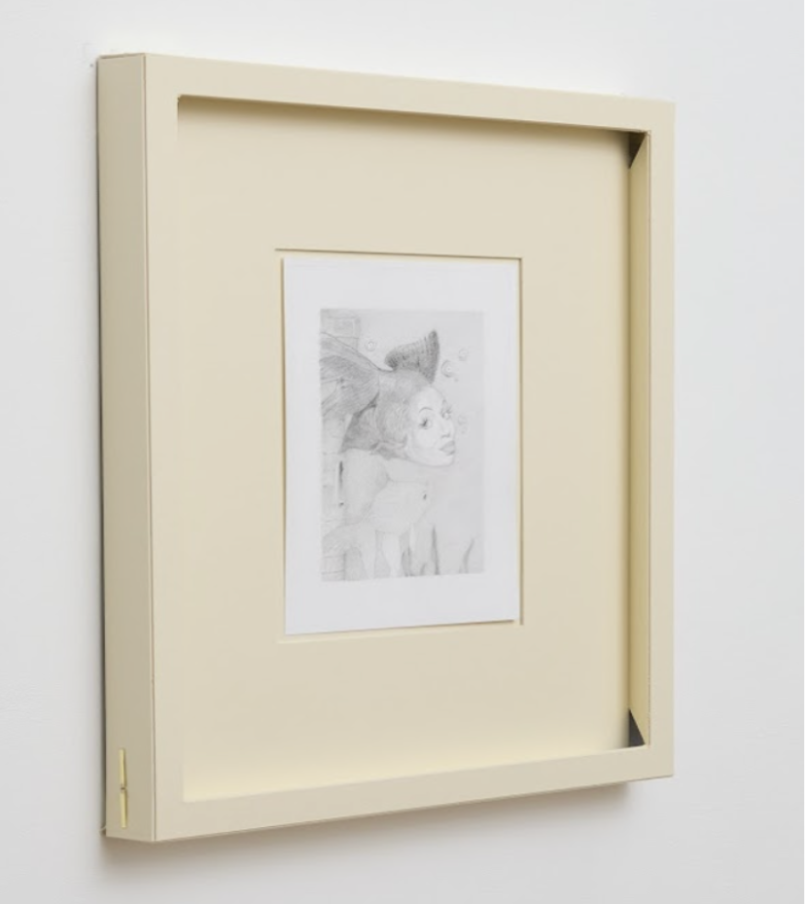"Alt-Craft" Review of Stuart McKenzie and Brad Kronz, Galerina at Arcadia Missa
Review / 11 April 2025 / By: James Spader / ★ ★ ★
The Old Grey Liver Test, Curated by Galerina at Arcadia Missa
There was no overarching theme in Old Grey Liver Test. A cursory glance at the artwork list, which reads titles like “Youth cult synthesis” or “Dead at 55” alongside the title's explicit reference to a rock-defining 70s show, The Old Grey Whistle Test, makes clear an intention to reach a sardonic middle ground between sincerity and outright irony.
Youth Cult Synthesis, or Dead at 55, 2024, is contained within a neon-orange wood frame. Paracetamol instruction leaflets are layered on top of each other, the text sutured together through a technique (welting) particular to pocket making. As the show text notes, this skill was learnt in Mckenzies days as a studio assistant for Vivienne Westwood - a fact that lends the artist’s late 90s works And I’m Not going to let you wear me like a Tie Pin (1998) and Who Can Out Ferry Ferry (1998) a punky gravitas. These earlier pieces combine tacky, collaged strips of leopard print, the words “Bryan Ferry” written in cursive and a brooding, B&W portrait of the 80s singer. The effect is a fantastically dated, fragmented image of what it is to be a metrosexual ballad singer. McKenzie’s work makes me wonder what it feels like to have one's youth fetishised as a romantic idyll, your memories translated into collective nostalgia, and to laugh about it. Which discarded memories from our time might be framed: a fidget spinner, an obsession with identity, an ironic starter-pack meme?
In Stuart McKenzie’s Left Right, Left Right (2024) the word “Alt” appears on a square of printer tape, hand cut from food packaging. Above, the words “Left, Right, Left, Right” appear printed, like military steps, from a label maker. This semi-serious commentary on our misguided, but ultimately regimented contemporary vision of “The Alternate” (alt-girl, alt-boy) contrasts with less political collages like E’s ruining My Life (2024) whose text reads “Mistaka” on one line and “E,E,E” on another, but is more obviously funny than Gender Critical (2024) which simply reads “He is He”. Sarcasm was inherent to the show - something that feels, now, far more refreshing than an outmoded sincerity.
Brad Kronz’s works are witty, but not about pop culture. In 80s, 70s, a diagrammatic pencil drawing of a shaded square labelled “70s” containing a lighter square labelled “80s”. The paper is framed by two thick, wooden blocks where Kronz has placed strips of paper at an obtuse angle - acting as a sort of theatrical curtain for the minimal drawing. It’s a commentary on performativity within timelines and art historical nomenclature that is felt but not overstated. 80s, 70s aesthetically pleases like a mid-century modern drinks cabinet, while commenting on something as nebulous and subjective as decades.
The curious part of Kronz's works is the presence of the figurative. For Independent Artist (2025) Kronz cuts out the internal corners of the frame, forming pockets of shadow that can’t be seen from a frontal view. Frame and drawing become subsumed into a singular artwork, contrasting the separation of the two in McKenzie’s pieces. Kronz’s soft, graphite lines depict, unnervingly, a cartoon fish with a woman's face. Faintly nïave, slightly perverse, resembling a pre-millennium illustrated children’s character or a Henry Darger prepubescent girl.
Old Grey Liver Test is the antithesis of what is leveraged in the more mainstream, highly publicised art world. A show in summer at The Approach made it clear the veracity with which people impose the past onto an indifferent contemporaneity, comparing a new graduate class with the YBA’s, albeit, “more friendly, supportive, inclusive, diverse and international”. Old Grey Liver Test is curated by Galerina, a nomadic gallery run by two twenty-something’s. I felt a strange relief at seeing a show that was not groundbreaking. It neededn't be; it was not trying to redefine, rehash, or rebut anything. The curation proposed a witty, slightly tongue-in-cheek conversation between friends about taste, material fetish and personal nostalgia, focusing on the artists’ careful attention to craftsmanship, wood-making and paper constructs, collage and sewing, word-play and framing.

